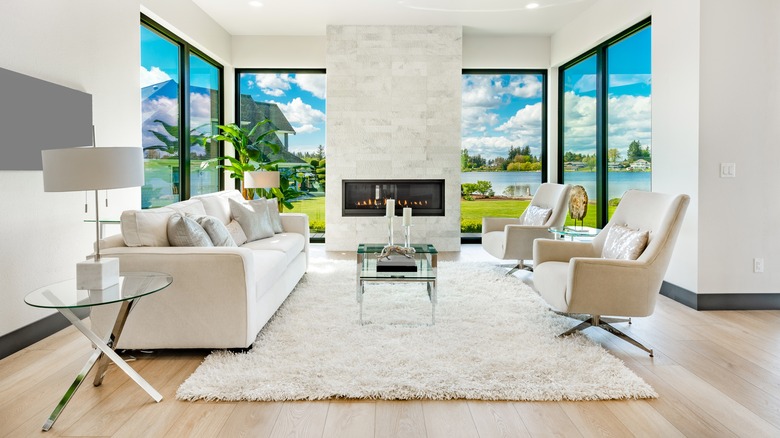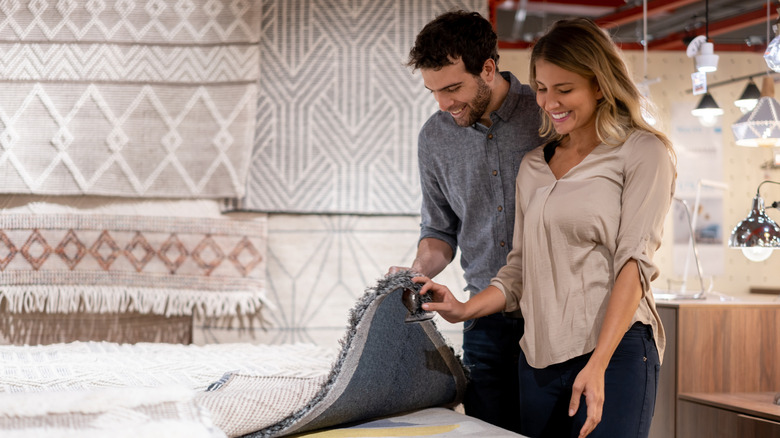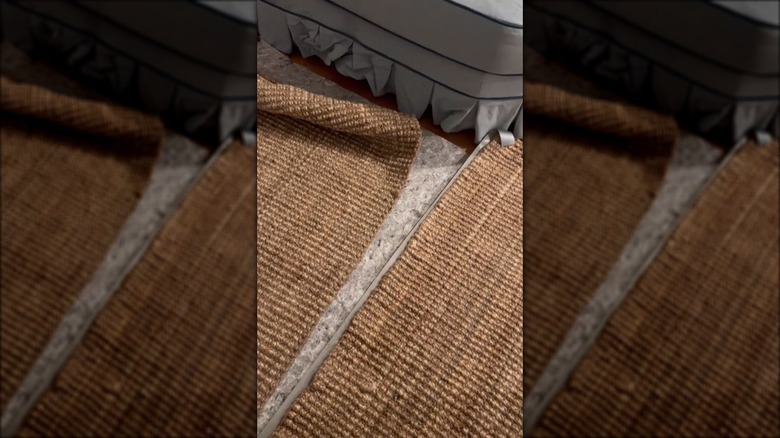Here's The Budget-Friendly Design Trick That Creates One Big Area Rug For Less
Area rugs can transform a room by making it more aesthetic and cozy, and pets tend to appreciate the added layer of comfort, too. If you plan to cover a large area, however, you could face inconveniences like struggling to find the right size and dealing with the hefty price tag of large area rugs. This leaves many homeowners settling for smaller rugs and exposing more of the floor than they'd like. Maybe you're one of them, but have you ever thought about making your own large area rug by combining two rugs together? A couple TikTokers shared their budget-friendly design tricks in which they did just that. All you need is a tape measure and duct tape, and within minutes, you can convert two area rugs into one large floor covering for any room (via TikTok).
It's genius, right? Large area sizes vary, ranging from 9 feet by 12 feet, 10 feet by 14 feet, and so on, so combining two smaller rugs can create a rug of a comparable size. You can run the tape along the entire edge of one rug if you're aiming for a seamless look. Otherwise, you can place the tape perpendicular to the edges of the rugs (via TikTok). Just be sure to measure the floor first before selecting your rugs, and consider the items that will be placed on and around the rugs.
Choosing the right rug size for your space
Before finding the best rug for your space and mimicking the TikTok trick, use a tape measure to determine the length and width of the floor area you wish to cover. In many cases, you'll be able to get the dimensions you seek by purchasing two rugs of the same size. On the other hand, you may already have one rug that you simply wish to expand. Or, you may want to purchase two rugs of differing sizes to get a rug with specific dimensions, such as a 3 by 5 foot and a 5 by 8 foot to get a 5 by 11 foot floor covering.
If your rugs are both the same size, you'll likely want to double the width by taping the long sides together. Taping the short sides would, of course, give you a more oblong, rectangular rug. Note that when you combine two equal-sized rugs together, either the width or the length will double, not both. So if you combine two 5 by 7 foot rugs, you won't create a 10 by 14 foot rug. Instead, you'll be left with a 7 by 10 foot or a 5 by 14 foot rug, depending on if you combine the rugs lengthwise or widthwise. Here is a more specific example: If your living room is 12 by 18 feet, and you want to cover the floor in front of the seating area, you can combine two 5 by 7 foot rugs to create a 7 by 10 rug.
The do's and don'ts of taping area rugs together
Once you've purchased your rug, or rugs, prepare the first one that you plan to tape. If you're aiming for an almost seamless look, add a long piece of tape along the edge of your rug, with about 1 inch of tape sticking from the edge. The rug and tape should both be facing upwards. Then, connect the other rug by placing it on top of the tape that's along the edge of the other rug. If the seam is larger than you'd like, you can hide it by placing a coffee table on top or by creating a layering effect with a smaller area rug.
If your rugs have a specific geometric pattern, you might prefer a more disjointed look. In this case, you won't need as much tape; simply flip both rugs upside down and apply a few strips of tape perpendicular to the seam. Then slowly flip the rugs right-side up to reveal the finished product. Another factor to keep in mind when taping rugs together is the surrounding items in the room. If the rugs are in an open area, the risk of separation could increase from foot traffic — if you have kids or pets who like to run around the house. Bordering the rugs with furniture could deter any fast foot traffic and lower this risk. Regardless of your room fixtures, taping two rugs together can be a great way to create a large rug with a small price tag.


